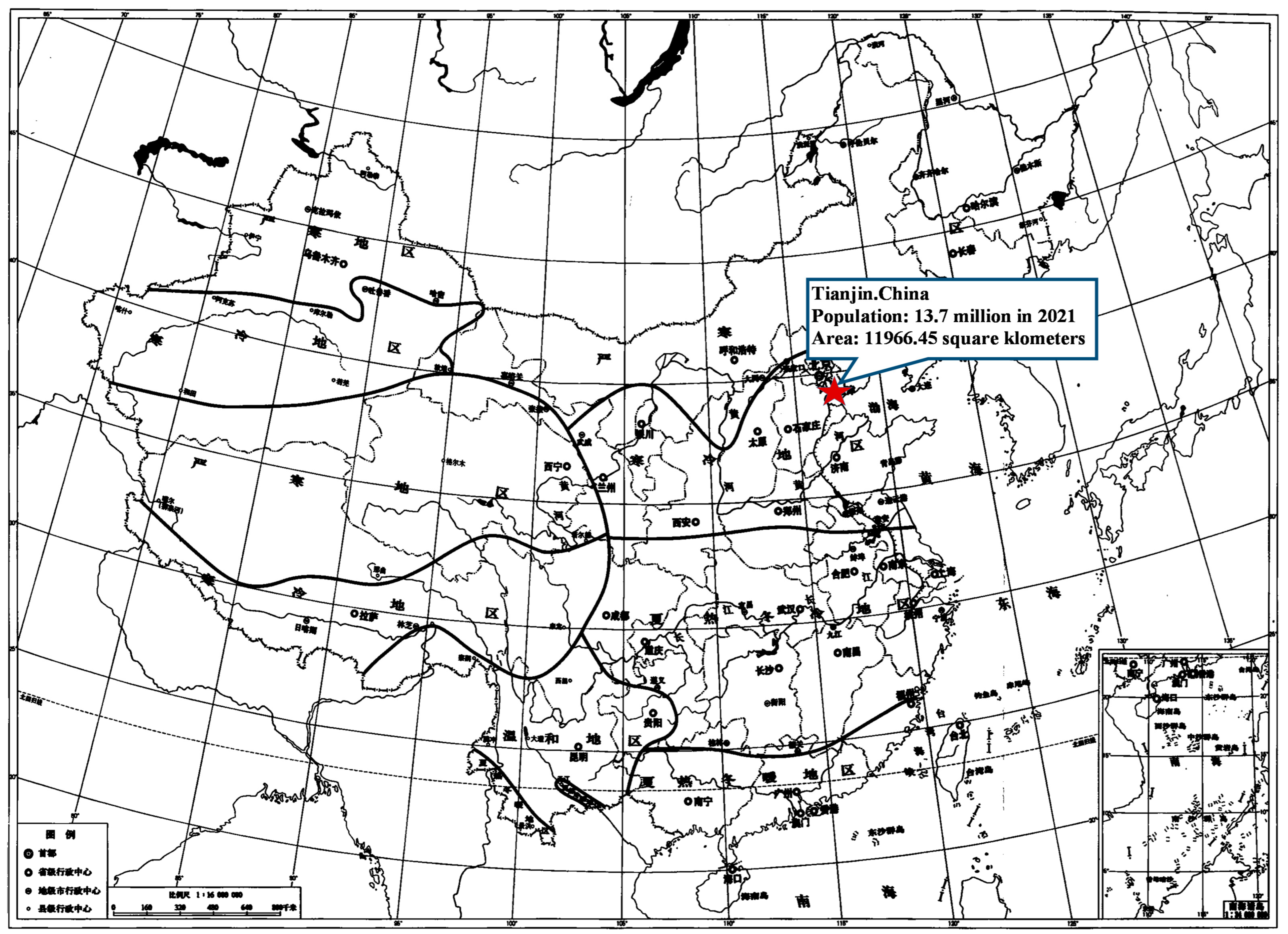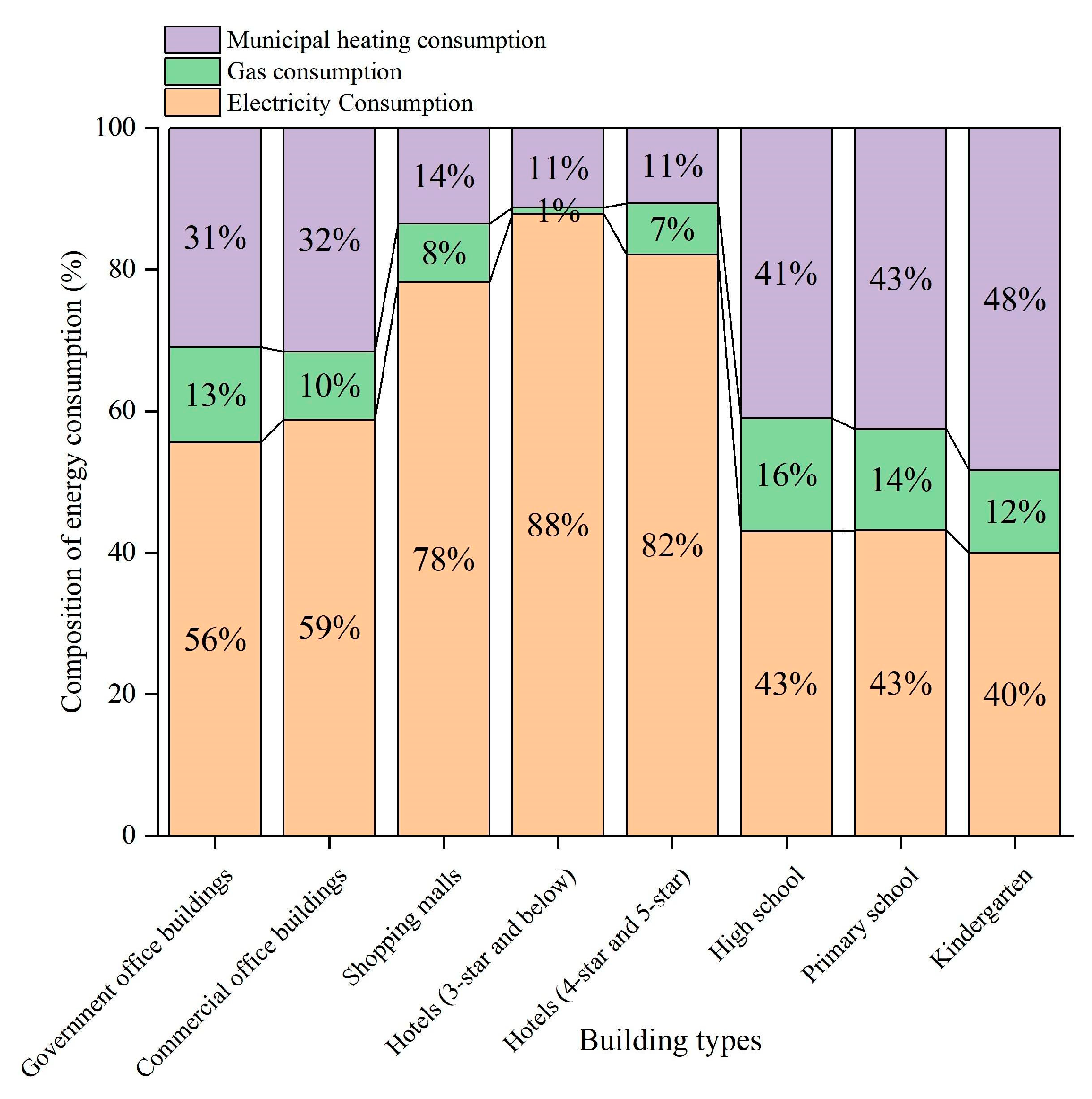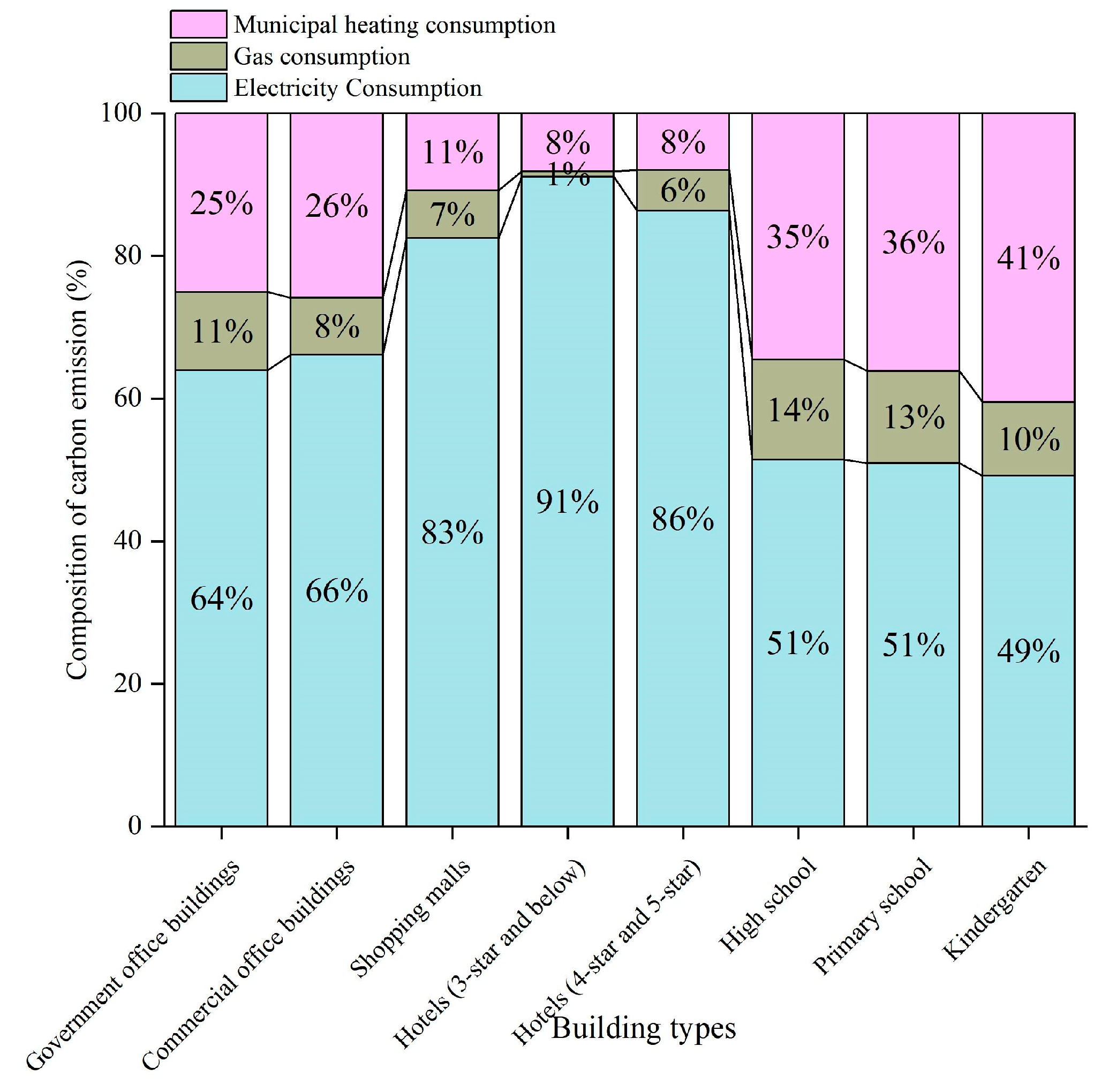Research on the Carbon Emission Baselines for Different Types of Public Buildings in a Northern Cold Areas City of China
Abstract
:1. Introduction
2. Materials and Methods
2.1. Study Area and Data
2.2. Algorithm for Calculating Building Carbon Emission Baseline
2.3. Carbon Emission Calculation Method
3. Results and Discussion
3.1. Energy Consumption
3.2. Analysis of Carbon Emissions
3.2.1. Composition of Carbon Emissions
3.2.2. Correlation Analysis between Building Area and Carbon Emissions
3.2.3. Correlation Analysis between Building’s Construction Age and Carbon Emissions
3.3. Comparison of Building Carbon Emission Baselines according to two Calculation Methods
3.4. Dynamic Baseline of Carbon Emissions in Public Buildings during the Period 2022–2030
4. Conclusions
Author Contributions
Funding
Data Availability Statement
Conflicts of Interest
Nomenclature
| EFc | Comprehensive carbon emission factor of the building |
| ECe | Electricity consumption per unit area of the building |
| ECg | Natural gas consumption per unit area of the building |
| ECm | Municipal thermal energy consumption per unit area of the building |
| C | Carbon emission per unit area of the building |
| HVAC | Heating Ventilation and Air Conditioning |
| EC | Total energy consumption per unit area of the building |
| EFgrid | Carbon emission factor of the power grid in Tianjin |
| EFnatural gas | Carbon emission factor of natural gas per unit mass |
| EFmunicipal heat | Carbon emission factor of regional central heating in Tianjin |
| EUI | Total energy consumption per unit of floor area |
References
- Keatinge, W.R.; Donaldson, G.C. The impact of global warming on health and mortality. South. Med. J. 2004, 97, 1093–1100. [Google Scholar] [CrossRef] [PubMed]
- Röck, M.; Saade, M.; Balouktsi, M.; Rasmussen, F.; Birgisdottir, H.; Frischknecht, R. Embodied GHG emissions of buildings—The hidden challenge for effective climate change mitigation. Appl. Energy 2020, 258, 114107. [Google Scholar] [CrossRef]
- Schleussner, C.F.; Rogelj, J.; Schaeffer, M.; Lissner, T.; Licker, R.; Fischer, E.M.; Knutti, R.; Levermann, A.; Frieler, K.; Hare, W. Science and policy characteristics of the Paris Agreement temperature goal. Nat. Clim. Chang. 2016, 6, 827–835. [Google Scholar] [CrossRef]
- American Government. Executive Order on Tackling the Climate Crisis at Home and Abroad. Available online: https://www.whitehouse.gov/briefing-room/presidential-actions/2021/01/27/executive-order-on-tackling-the-climatecrisis-at-home-and-abroad/ (accessed on 15 December 2022).
- European Commission. European Climate Law. Available online: https://ec.europa.eu/clima/policies/eu-climate-action/law_en (accessed on 15 December 2022).
- The Government of China. The Outline of the 14th Five-Year Plan (2021–2025) for National Economic and Social Development and the Long-Range Objectives through the Year 2035. Available online: http://www.gov.cn/xinwen/2021-03/13/content_5592681.htm (accessed on 15 December 2022).
- United Nations Environment Programme. Emissions Gap Report 2022: The Closing Window—Climate Crisis Calls for Rapid Transformation of Societies, Nairobi, 2022. Available online: https://www.unep.org/emissions-gap-report-2022 (accessed on 15 December 2022).
- CABEE. China Building Energy Consumption and Carbon Emissions Research Report. Chongqing, 2020. Available online: https://www.cabee.org/site/content/24021.html (accessed on 15 December 2022).
- Boehm, S.; Jeffery, L.; Levin, K.; Hecke, J.; Schumer, C.; Fyson, C.; Majid, A.; Jaeger, J.; Nilsson, A.; Naimoli, S.; et al. State of Climate Action 2022; World Resources Institute: Washington, DC, USA, 2022. [Google Scholar] [CrossRef]
- MOHURD. General Code for Energy Efficiency and Renewable Energy Application in Buildings; GB 55015-2021; China Architecture & Building Press: Beijing, China, 2021. (In Chinese)
- MOHURD. Design Standard for Energy Efficiency of Public Buildings; GB 50189-2015; China Architecture & Building Press: Beijing, China, 2015. (In Chinese)
- The Government of China. Establish and Improve the Implementation Plan of Carbon Peaking Carbon Neutral Standard Metering System. Available online: http://www.gov.cn/zhengce/zhengceku/2022/11/01/content_5723071.htm (accessed on 17 December 2022).
- Droutsa, K.G.; Balaras, C.A.; Lykoudis, S.; Kontoyiannidis, S.; Dascalaki, E.G.; Argiriou, A.A. Baselines for energy use and carbon emission intensities in hellenic nonresidential buildings. Energies 2020, 13, 2100. [Google Scholar] [CrossRef]
- Wu, X.; Priyadarsini, R.; Eang, L.S. Benchmarking energy use and greenhouse gas emissions in Singapore’s hotel industry. Energy Policy 2010, 38, 4520–4527. [Google Scholar]
- Huang, K.-T.; Wang, J.C.; Wang, Y.-C. Analysis and benchmarking of greenhouse gas emissions of luxury hotels. Int. J. Hosp. Manag. 2015, 51, 56–66. [Google Scholar] [CrossRef]
- Lai, J.; Lu, M. Analysis and benchmarking of carbon emissions of commercial buildings. Energy Build. 2019, 199, 445–454. [Google Scholar] [CrossRef]
- Feng, F.; Fu, Y.; Yang, Z.; O’Neill, Z. Enhancement of phase change material hysteresis model: A case study of modeling building envelope in EnergyPlus. Energy Build. 2022, 276, 112511. [Google Scholar] [CrossRef]
- Queiroz, N.; Westphal, F.S.; Pereira, F.O.R. A performance-based design validation study on EnergyPlus for daylighting analysis. Build. Environ. 2020, 183, 107088. [Google Scholar] [CrossRef]
- Park, J.H.; Jeon, J.; Lee, J.; Wi, S.; Yun, B.Y.; Kim, S. Comparative analysis of the PCM application according to the building type as retrofit system. Build. Environ. 2019, 151, 291–302. [Google Scholar] [CrossRef]
- Li, H.; Fu, Z.; Xi, C.; Li, N.; Li, W.; Kong, X. Study on the impact of parallel jet spacing on the performance of multi-jet stratum ventilation. Appl. Energy 2022, 306, 118135. [Google Scholar] [CrossRef]
- Huang, H.; Wang, H.; Hu, Y.J.; Li, C.; Wang, X. Optimal plan for energy conservation and CO2 emissions reduction of public buildings considering users’ behavior: Case of China. Energy 2022, 261, 125037. [Google Scholar] [CrossRef]
- Mazzeo, D.; Matera, N.; Cornaro, C.; Oliveti, G.; Romagnoni, P.; De Santoli, L. EnergyPlus, IDA ICE and TRNSYS predictive simulation accuracy for building thermal behaviour evaluation by using an experimental campaign in solar test boxes with and without a PCM module. Energy Build. 2020, 212, 109812. [Google Scholar] [CrossRef]
- Lu, S.; Wei, S.; Zhang, K.; Kong, X.; Wu, W. Investigation and analysis on the energy consumption of starred hotel buildings in Hainan Province, the tropical region of China. Energy Convers. Manag. 2013, 75, 570–580. [Google Scholar] [CrossRef]
- Lu, Y.; Tian, Z.; Zhou, R.; Liu, W. A general transfer learning-based framework for thermal load prediction in regional energy system. Energy 2021, 217, 119322. [Google Scholar] [CrossRef]
- Kong, X.; Lu, S.; Gao, P.; Zhu, N.; Wu, W.; Cao, X. Research on the energy performance and indoor environment quality of typical public buildings in the tropical areas of China. Energy Build. 2012, 48, 155–167. [Google Scholar] [CrossRef]
- Khayatian, F.; Sarto, L. Application of neural networks for evaluating energy performance certificates of residential buildings. Energy Build. 2016, 125, 45–54. [Google Scholar] [CrossRef]
- Jeong, K.; Hong, T.; Kim, J. Development of a CO2 emission benchmark for achieving the national CO2 emission reduction target by 2030. Energy Build. 2018, 158, 86–94. [Google Scholar] [CrossRef]
- Ikotun, A.M.; Ezugwu, A.E.; Abualigah, L.; Abuhaija, B.; Heming, J. K-means Clustering Algorithms: A Comprehensive Review, Variants Analysis, and Advances in the Era of Big Data. Inf. Sci. 2022, 622, 178–210. [Google Scholar] [CrossRef]
- Yang, Z.; Roth, J.; Jain, R.K. DUE-B: Data-driven urban energy benchmarking of buildings using recursive partitioning and stochastic frontier analysis. Energy Build. 2018, 163, 58–69. [Google Scholar] [CrossRef]
- Chung, W. Review of building energy-use performance benchmarking methodologies. Appl. Energy 2011, 88, 1470–1479. [Google Scholar] [CrossRef]
- Zeng, X.; Zhou, Z.; Gong, Y.; Liu, W. A data envelopment analysis model integrated with portfolio theory for energy mix adjustment: Evidence in the power industry. Socio-Econ. Plan. Sci. 2022, 83, 101332. [Google Scholar] [CrossRef]
- Lee, W.S. Benchmarking the energy efficiency of government buildings with data envelopment analysis. Energy Build. 2008, 40, 891–895. [Google Scholar] [CrossRef]
- Qaisar, I.; Zhao, Q. Energy baseline prediction for buildings: A review. Results Control. Optim. 2022, 7, 100129. [Google Scholar] [CrossRef]
- Xiao, F.; Fan, C. Data mining in building automation system for improving building operational performance. Energy Build. 2014, 75, 109–118. [Google Scholar] [CrossRef]
- MOHURD. Standard for Building Carbon Emission Calculation; GB/T51366-2019; China Architecture & Building Press: Beijing, China, 2019. (In Chinese)
- National Development and Reform Commission. 2010 China’s Average Carbon Dioxide Emission Factor of Regional and Provincial Power Grids. Available online: https://www.ccchina.org.cn/ (accessed on 17 December 2022).
- Jiang, M.P.; Tovey, K. Overcoming barriers to implementation of carbon reduction strategies in large commercial buildings in China. Build. Environ. 2010, 45, 856–864. [Google Scholar] [CrossRef]
- Bağcı, B. Energy saving potential for a high-rise office building. Intell. Build. Int. 2009, 1, 156–163. [Google Scholar] [CrossRef]
- Jing, R.; Wang, M.; Zhang, R.; Li, N.; Zhao, Y. A study on energy performance of 30 commercial office buildings in Hong Kong. Energy Build. 2017, 144, 117–128. [Google Scholar] [CrossRef]
- Wallhagen, M.; Glaumann, M.; Malmqvist, T. Basic building life cycle calculations to decrease contribution to climate change—Case study on an office building in Sweden. Build. Environ. 2011, 46, 1863–1871. [Google Scholar] [CrossRef]
- Braslavsky, J.H.; Wall, J.R.; Reedman, L.J. Optimal distributed energy resources and the cost of reduced greenhouse gas emissions in a large retail shopping centre. Appl. Energy 2015, 155, 120–130. [Google Scholar] [CrossRef]
- Garg, A.; Maheshwari, J.; Shukla, P.; Rawal, R. Energy appliance transformation in commercial buildings in India under alternate policy scenarios. Energy 2017, 140, 952–965. [Google Scholar] [CrossRef]
- Acha, S.; Mariaud, A.; Shah, N.; Markides, C.N. Optimal design and operation of distributed low-carbon energy technologies in commercial buildings. Energy 2018, 142, 578–591. [Google Scholar] [CrossRef]
- The People’s Government of Tianjin Municipality. Implementation Plan of Carbon Peak in Tianjin. Available online: https://www.tj.gov.cn/zwgk/szfwj/tjsrmzf/202209/t20220914_5987984.html (accessed on 20 December 2022).









| Study No. | Location | Building Type | Sample Size | Energy Utilization Index (EUI) (kWh/m2/a) | Carbon Emission (kgCO2/m2/a) |
|---|---|---|---|---|---|
| 1 | Hong Kong, China | Office | 1 | 330 | 273.8 |
| 2 | Beijing, China | Commercial | 5 | 173 | 178 |
| 3 | Shanghai, China | Commercial | 4 | 132 | 119 |
| 4 | Singapore | Hotel | 29 | 427 | 221.8 |
| 5 | Sweden | Office | 1 | 100 | 2.7 |
| 6 | Hong Kong, China | Hotel | 3 | N.A. | 168–288 |
| 8 | Taiwan, China | Hotel | 58 | 277 | 132 |
| 9 | Gujarat, India | Commercial | 197 | 98–181 | 96–177 |
| 10 | Hong Kong, China | Office | 30 | 236 | 190 |
| 11 | Bristol, UK | Commercial | 1 | 1107 | 250 |
| 12 | China | Office | 362 | N.A. | 73.45 |
| 13 | Hong Kong, China | Retail and office | 32 | 115.7 | 69.6 |
| Type of Energy Supply | Carbon Emission Factor |
|---|---|
| Power grid | 0.78 (kgCO2/kWh) |
| Natural gas | 2.02 (kgCO2/m3) |
| Regional central heating | 0.60 (kgCO2/kWh) |
| Building Types | Correlation Coefficient |
|---|---|
| Government office buildings | 0.015 |
| Commercial office buildings | −0.192 |
| Shopping malls | −0.078 |
| Hotels (3-star and below) | 0.448 |
| Hotels (4-star and 5-star) | 0.272 |
| High school | −0.169 |
| Primary school | −0.298 |
| Kindergarten | −0.141 |
| Building Types | Correlation Coefficient |
|---|---|
| Government office buildings | −0.121 |
| Commercial office buildings | −0.557 |
| Shopping malls | −0.152 |
| 3-star (and below) hotels | −0.248 |
| 4-star and 5-star hotels | −0.216 |
| High school | −0.209 |
| Primary school | −0.271 |
| Kindergarten | −0.454 |
| Year | Building Types/Predicted Value | Government Office Buildings | Commercial Office Buildings | Shopping Malls | Hotels (3-Star and below) | Hotels (4-Star and 5-Star) | High School | Primary School | Kindergarten |
|---|---|---|---|---|---|---|---|---|---|
| kgCO2/m2 | kgCO2/m2 | kgCO2/m2 | kgCO2/m2 | kgCO2/m2 | kgCO2/m2 | kgCO2/m2 | kgCO2/m2 | ||
| 2022 | Advanced value | 42.70 | 31.58 | 44.64 | 34.75 | 54.86 | 28.66 | 28.21 | 32.65 |
| Guiding value | 52.89 | 42.05 | 63.84 | 61.44 | 74.03 | 34.53 | 35.14 | 39.28 | |
| Constraint value | 70.12 | 62.25 | 84.79 | 90.83 | 92.37 | 42.60 | 41.52 | 44.42 | |
| 2024 | Advanced value | 42.11 | 31.22 | 43.56 | 34.06 | 53.61 | 28.40 | 27.96 | 32.31 |
| Guiding value | 52.01 | 41.56 | 62.31 | 59.98 | 72.79 | 34.17 | 34.73 | 38.81 | |
| Constraint value | 69.30 | 60.91 | 83.10 | 88.72 | 90.74 | 41.90 | 40.95 | 43.86 | |
| 2026 | Advanced value | 41.53 | 30.87 | 42.52 | 33.39 | 52.40 | 28.08 | 27.73 | 31.99 |
| Guiding value | 51.04 | 41.07 | 60.82 | 58.56 | 71.59 | 33.67 | 34.33 | 38.35 | |
| Constraint value | 68.05 | 59.72 | 81.47 | 86.67 | 89.16 | 41.33 | 40.42 | 43.32 | |
| 2028 | Advanced value | 40.98 | 30.53 | 41.52 | 32.74 | 51.22 | 27.68 | 27.49 | 31.68 |
| Guiding value | 50.10 | 40.37 | 59.38 | 57.22 | 70.42 | 33.21 | 33.90 | 37.91 | |
| Constraint value | 66.79 | 58.68 | 79.84 | 84.69 | 87.63 | 40.77 | 40.06 | 42.74 | |
| 2030 | Advanced value | 40.39 | 30.19 | 40.78 | 32.09 | 50.05 | 27.44 | 27.26 | 31.36 |
| Guiding value | 49.28 | 39.61 | 57.94 | 56.27 | 69.26 | 32.84 | 33.51 | 37.46 | |
| Constraint value | 65.53 | 57.63 | 77.90 | 82.71 | 86.10 | 40.22 | 39.78 | 42.14 |
Disclaimer/Publisher’s Note: The statements, opinions and data contained in all publications are solely those of the individual author(s) and contributor(s) and not of MDPI and/or the editor(s). MDPI and/or the editor(s) disclaim responsibility for any injury to people or property resulting from any ideas, methods, instructions or products referred to in the content. |
© 2023 by the authors. Licensee MDPI, Basel, Switzerland. This article is an open access article distributed under the terms and conditions of the Creative Commons Attribution (CC BY) license (https://creativecommons.org/licenses/by/4.0/).
Share and Cite
Li, X.; Li, Y.; Zhou, H.; Fu, Z.; Cheng, X.; Zhang, W. Research on the Carbon Emission Baselines for Different Types of Public Buildings in a Northern Cold Areas City of China. Buildings 2023, 13, 1108. https://doi.org/10.3390/buildings13051108
Li X, Li Y, Zhou H, Fu Z, Cheng X, Zhang W. Research on the Carbon Emission Baselines for Different Types of Public Buildings in a Northern Cold Areas City of China. Buildings. 2023; 13(5):1108. https://doi.org/10.3390/buildings13051108
Chicago/Turabian StyleLi, Xiaoping, Yitong Li, Haizhu Zhou, Zheng Fu, Xionglei Cheng, and Wei Zhang. 2023. "Research on the Carbon Emission Baselines for Different Types of Public Buildings in a Northern Cold Areas City of China" Buildings 13, no. 5: 1108. https://doi.org/10.3390/buildings13051108




